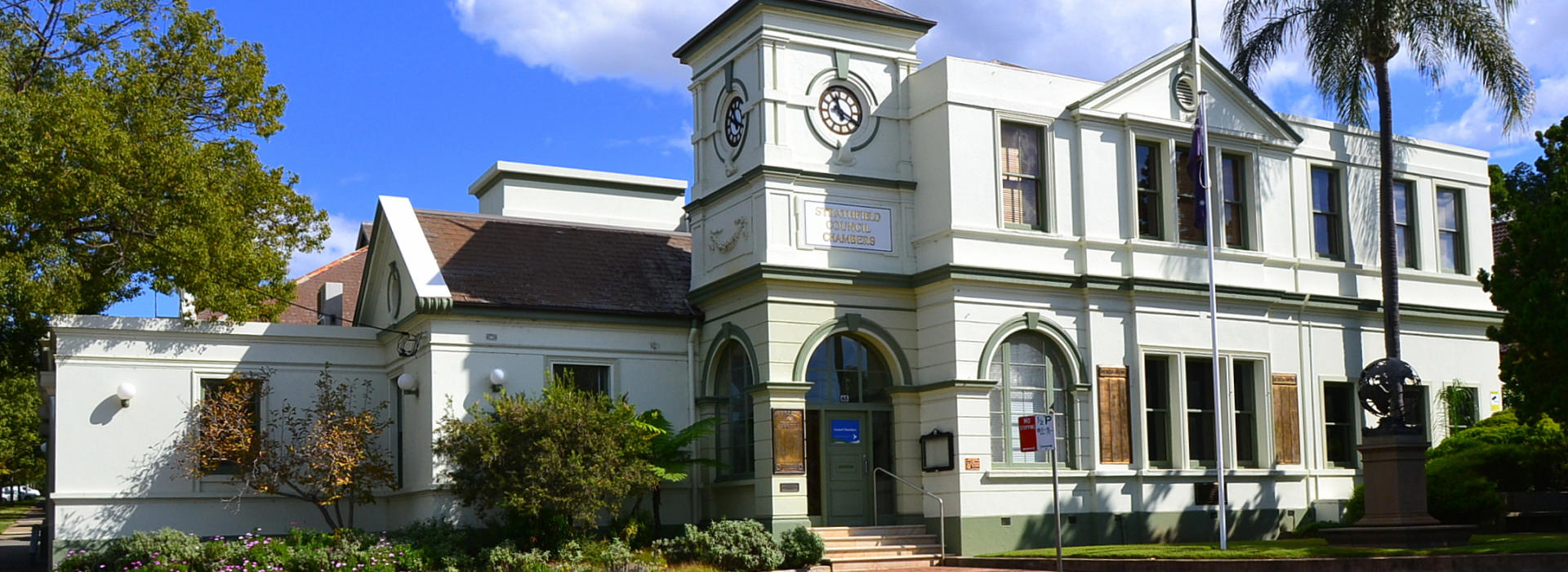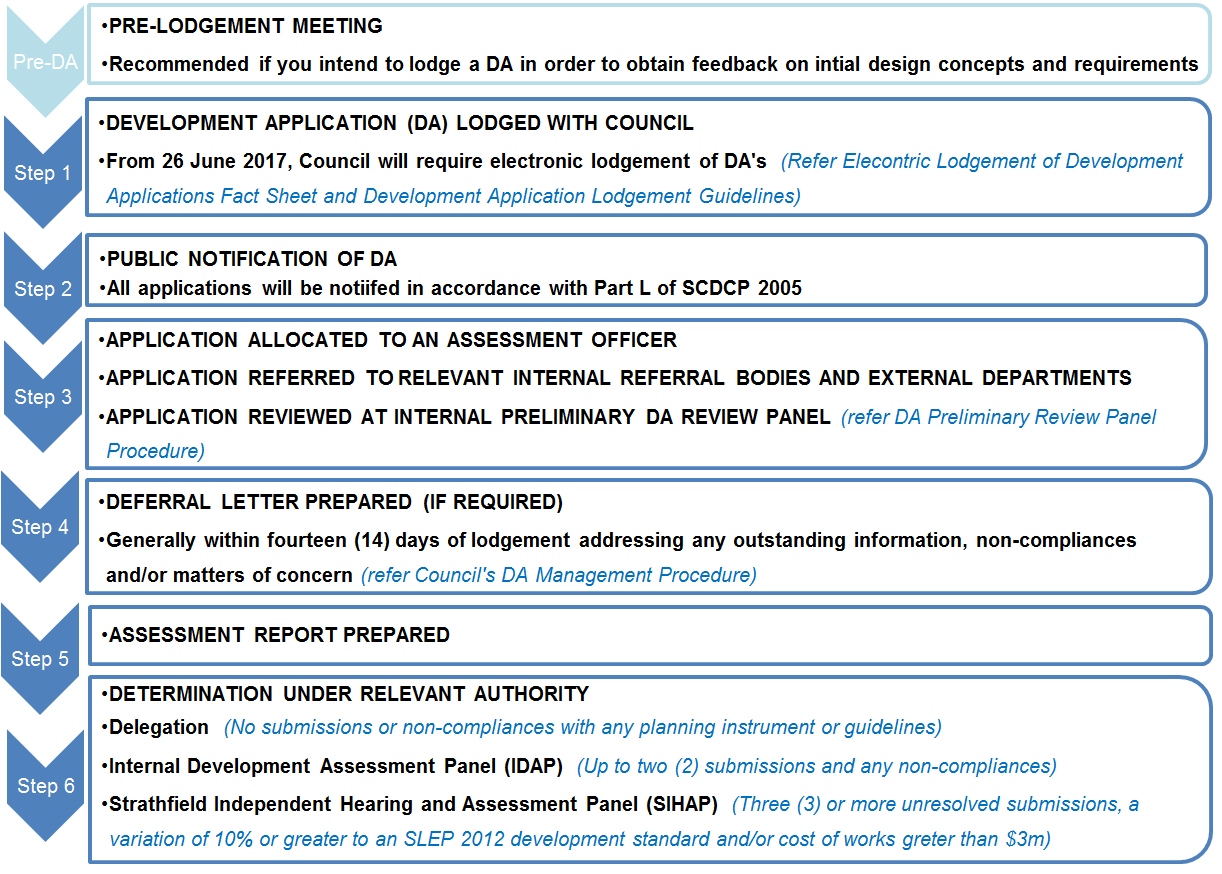
Development Applications
From 1 July 2020, all planning applications, including Development Applications and Complying Development Certificates for Strathfield Council will need to be electronically lodged online via the NSW Government Planning Portal.
The new process enables customers to lodge applications anytime using the online portal.
Paper applications will no longer be accepted.
Council’s Duty Planners are available on 02 9748 9999 or council@strathfield.nsw.gov.au to provide advice and assistance.
Please click here for further information and how-to-guides outlining the steps for the new development application process.
Before you can make changes to a building, you may need to a lodge a Development Application.
A Development Application (DA) is a formal request for consent to carry out development. This type of development approval is the most common way of obtaining development consent in NSW.
In this section of the website you will find all the information required to lodge a DA.
Accessing Development Applications
Development applications and associated documents are ‘open access’ documents under the Government Information (Public Access) Regulation 2009, with the exception of:
- the plans and specifications for any residential parts of a proposed building, other than plans that merely show its height and its external configuration in relation to the site on which it is proposed to be erected; or
- commercial information, if the information would be likely to prejudice the commercial position of the person who supplied it or to reveal a trade secret.
Development applications currently on public exhibition are notified below.
If you are seeking copies of development applications which are no longer on exhibition, please contact Council on 9748 9999. Upon request, Council will make documents available for inspection, copying or where possible, publication via the website.
Copy of documents is provided by Strathfield Council for information purposes only, as required by relevant legislation. Copyright laws still apply to these documents. Some documents may been amended (redacted) in order to protect personal information such as phone numbers, fax numbers and signatures.
A development application (DA) is required for most development in the local area.
Development is defined under the Environmental Planning and Assessment Act as:
-
the use of land;
-
the subdivision of land;
-
the erection of a building;
-
the carrying out of work;
-
pruning or removing trees;
-
demolition;and
-
any other matter controlled by an environmental planning instrument.
To obtain development consent you must lodge a development application with Council. However, some minor development, called exempt development does not require consent. Another type of development called complying development, requires a complying development certificate. These are discussed below.
Should you have any further questions, please contact Council’s Duty Planner on (02) 9748 9999.
What is Exempt Development?
Some minor building works don’t require any planning or building approval. This is called exempt development. Exempt development is very low impact development that can be done for certain residential, commercial and industrial properties. Provided your building project meets specific development standards under State Environmental Planning Policy (Exempt and Complying Development) 2008, approval from Council is not needed.
A few examples of development that can be exempt are: decks, garden sheds, carports, fences, repairing a window or painting a house. As long as the proposed works meet all of the development standards identified in the State Policy for exempt and complying development, approval may not be needed.
What is Complying Development?
Complying Development is a combined planning and construction approval for straightforward development that can be determined through a fast track assessment by a council or private accredited certifier. A Complying Development Certificate is generally determined within ten (10) days.
Complying development applies to homes, businesses and industry and allows for a range of development including construction of a new dwelling house, alterations and additions to a dwelling house, swimming pools, demolition and changes to a business use.
Determination of a Complying Development Certificate (CDC) relies on a code-based assessment against the relevant development standards provided within the State Environmental Planning Policy (Exempt and Complying Development Codes) 2008.
Note: If an application exceeds the relevant development standards contained within the State Policy, a development application will be required to be lodged with Council.
Heritage
Most work involving a listed heritage item (that is listed on the State Heritage Register or is subject to an interim heritage order under the Heritage Act 1977, or that is identified under Schedule 5 of the Strathfield Local Environmental Plan 2012) will require development consent from Council. However, there are provisions allowing for some minor works to be carried out involving heritage places, with the process for the different types of heritage listing outlined below:
Items listed under the Strathfield Local Environmental Plan 2012
For items listed under Schedule 5 of the Strathfield Local Environmental Plan 2012, there are some minor and maintenance works such as repointing, painting works, fencing maintenance, and the like that may be carried out without development consent. These minor works must be confirmed by Council in writing as exempt works before being carried out. An application form for this confirmation is available here.
Items within a listed Heritage Conservation Area
For land within a Heritage Conservation Area listed under Schedule 5 of the Strathfield Local Environmental Plan 2012, some types of exempt development are available under the State Environmental Planning Policy (Exempt and Complying Development Codes) 2008. The exempt provisions of the Strathfield Local Environmental Plan 2012 as described above for individual items also apply, and an application for minor heritage works may be submitted to Council for these properties.
Items on the State Heritage Register
For works involving an Item listed on the State Heritage Register under the Heritage Act 1977 (or a site that is subject to an Interim Heritage Order under that Act), you are advised to contact the Heritage Division, Office of Environment and Heritage for further information.
Electronic Housing Code
The Electronic Housing Code is a useful and free online system that helps to determine whether your proposal may be classified as ‘exempt’ or ‘complying’ development.

Duty Planner Service
For general planning advice, Council’s Duty Planner is available between 9am and 5pm Monday to Friday on (02) 9748 9999. Over the counter enquiries at Council’s Customer Service Centre are also welcome.
Council’s Duty Planner will be checking all applications prior to lodgement. Please note that lodgement of applications (DA and Section 4.55) will not be accepted after 4.45pm. This is to ensure that there is sufficient time to thoroughly check and lodge your application.
How to View Development Applications
Please click on the link below for further information and associated documents.
Information can also be viewed electronically at Council’s Customer Service Centre.
Council’s online Development Application Tracker is an online service that enables you to track current and recently determined development applications.
Christmas Public Notification of Development Applications, Section 4.55 and Section 8.2 Applications
During the Christmas and New Year period, notification for all Development Applications, Section 4.55 Applications and Section 8.2 Applications, will be extended beyond the regular notification periods to exclude any days between 20 December 2021 and 10 January 2022.
Further Enquiries
If you have any enquires regarding a development proposal, please contact Council’s Customer Service Centre on 9748 9999 to speak with the relevant Development Assessment Officer.
Development Applications Currently on Public Notification
The following Development Applications are currently on Public Notification:
Strathfield Council is pleased to offer an online service that enables you to track the progress of recently submitted or determined Development Applications (DAs) including modification applications and review of determination applications.
How to Track an Application
Click here to track the progress of a development application.
Further Enquiries
Should you have any questions, please contact Council’s Customer Service Centre on (02) 9748 9999 to speak with the Assessment Officer or Council’s Duty Planner.
Note: Council’s Duty Planner is available between 9am and 12pm Monday to Friday.
Pre-lodgement meetings are recommended if you intend to lodge a Development Application (DA) in order to obtain feedback on initial design concepts and Council’s technical requirements.
How to Submit Your Pre-lodgement Application
Pre-lodgement applications are to be submitted electronically on a CD or USB including one (1) paper copy set of all plans and documentation.
Fees
Pre-lodgement meeting fees are in accordance with Council’s adopted fees and charges.
Payment Methods
Payment can be made at Council’s Customer Service Centre by the following methods: cash, eftpos, cheque or money order (made payable to Strathfield Council) or by credit card – American Express, Diners Club, MasterCard or Visa.
Meeting Timings
Once an application is received by Council, meetings are generally organised by the Planner within two (2) weeks.
What Information is Required?
- Site plan, floor plans, elevations and sections for all proposed buildings (scale of 1:100 or 1:200 at A3)
- Site and context analysis (refer below)
- Stormwater concept diagram
- Materials, colours and finishes schedule
- Access and parking arrangements
- Draft landscape plan
- Photographs of the site and surrounding area
- Streetscape analysis showing a minimum of two buildings either side
- Non-compliances/variations from Council’s planning controls.
- Design issues that need to be discussed
- Details of any likely issues such as heritage, traffic, stormwater drainage, infrastructure needs, landscaping matters and environmental impacts
- Any other information you feel Council may need to assess your application
Site and Context Analysis
Good urban design improves the quality of the urban environment, its amenity, attractiveness, efficiency and cohesion. Successful integration of private buildings with the Public Domain requires care and skill in the design phase of any development.
Critical to this is context and site analysis involving a consideration of how the proposed development will respond to site constraints and integrate with the surrounds.
A site analysis should be prepared using a survey as a base and include the following:
- Site dimensions and area
- Existing structures
- Location of nearby heritage items or conservation areas
- Any easements and/or rights of carriageway
- Landscape features, steep slopes and existing vegetation on or near the site including trees to be retained or removed
- All adjoining properties, buildings and window opening locations
- Bar scale with text note and north point
- Important views to and from the site
- Contours and wind direction
- Soils and areas of site contamination
- Noise sources at and external to the site (including railway lines, arterial roads etc.)
- Opportunities and constraints for development
Public participation is an integral part of the development process.
Submissions Period
The submission period for each development application is in line with the notification period.
Can Anyone Make a Submission?
Any person is entitled to make a submission, which may object to or support an application whether or not a notification letter has been forwarded to the person.
Making a Submission
Submissions should include the following characteristics:
- The reasons for the objection or support
- Indicate the name(s), telephone number, street address and email address of the person(s) making the submission
- Quote the development application number and address of the property
- Any other documents (such as plans or photographs) to support the submission
- Suggestions of how the proposal may be modified to address the concerns raised
How to Lodge a Submission
Submissions can be submitted via email or post. Submissions submitted electronically are to be emailed to council@strathfield.nsw.gov.au. The subject of the email should include the word ‘submission’ as well as the Development Application number and address of the property.
Submissions submitted by post are to be addressed to the General Manager and posted to 65 Homebush Road, Strathfield NSW 2135.
Petitions
Where petitions are received in respect of an application, the principal petitioner or where not nominated, the first petitioner, will be acknowledged for the purpose of future contact. Only the principal petitioner will be advised of timings regarding the determination of an application.
Contact details including name, address, telephone number and email are to be provided for the principal petitioner.
Disclosure of Submissions
Submissions are not confidential. Submissions may be accessed by the public through an application to access Council’s records under the Government Information (Public Access) Act 2009.
Acknowledgement of Submissions
All submissions received by Council will be acknowledged as soon as practicable.
Anonymous Submissions
Anonymous submissions will not be considered.
Register of Clause 4.6 and SEPP 1 Variations
Development standards for each zone are set out in the Strathfield Local Environmental Plan 2012 (SLEP 2012). Ordinarily standards cannot be varied. However, Clause 4.6 of a standard instrument LEP permits Council to have some flexibility when applying planning controls.
There is no automatic right to vary a development standard with the onus placed the applicant to provide a written justification for the variation to the development standard. The test for granting a variation to a development standard is outlined in Clause 4.6(3) and (4) of the SLEP 2012.
Strathfield Municipal Council is required to provide a register of development applications where a variation to a development standard has been granted by Council. The register is submitted to the Department of Planning quarterly.
You can download Council’s variation register below:
2014
- Variation Register – 1 April 2014 to 30 June 2014
- Variation Register – 1 July 2014 to 30 September 2014
- Variation Register – 1 October 2014 to 31 December 2014
2015
- Variation Register – 1 January 2015 to 31 March 2015
- Variation Register – 1 April 2015 to 30 June 2015
- Variation Register – 1 July 2015 to 30 September 2015
- Variation Register – 1 October 2015 to 31 December 2015
2016
- Variation Register – 1 January 2016 to 31 March 2016
- Variation Register – 1 April 2016 to 30 June 2016
- Variation Register – 1 July 2016 to 30 September 2016
- Variation Register – 1 October 2016 to 31 December 2016
2017
- Variation Register – 1 January 2017 to 31 March 2017
- Variation Register – 1 April 2017 to 30 June 2017
- Variation Register – 1 July 2017 to 30 September 2017
- Variation Register – 1 October 2017 to 31 December 2017
2018
- Variation Register – 1 January 2018 to 31 March 2018
- Variation Register – 1 April 2018 to 30 June 2018
- Variation Register – 1 July 2018 to 30 September 2018
- Variation Register – 1 October 2018 to 31 December 2018
2019
- Variation Register – 1 January 2019 to 31 March 2019
- Variation Register – 1 April 2019 to 30 June 2019
- Variation Register – 1 July 2019 to 30 September 2019
- Variation Register – 1 October 2019 to 31 December 2019
2020
- Variation Register – 1 January 2020 to 31 March 2020
- Variation Register – 1 April 2020 to 30 June 2020
- Variation Register – 1 July 2020 to 30 September 2020
- Variation Register – 1 October 2020 to 31 December 2020
2021

